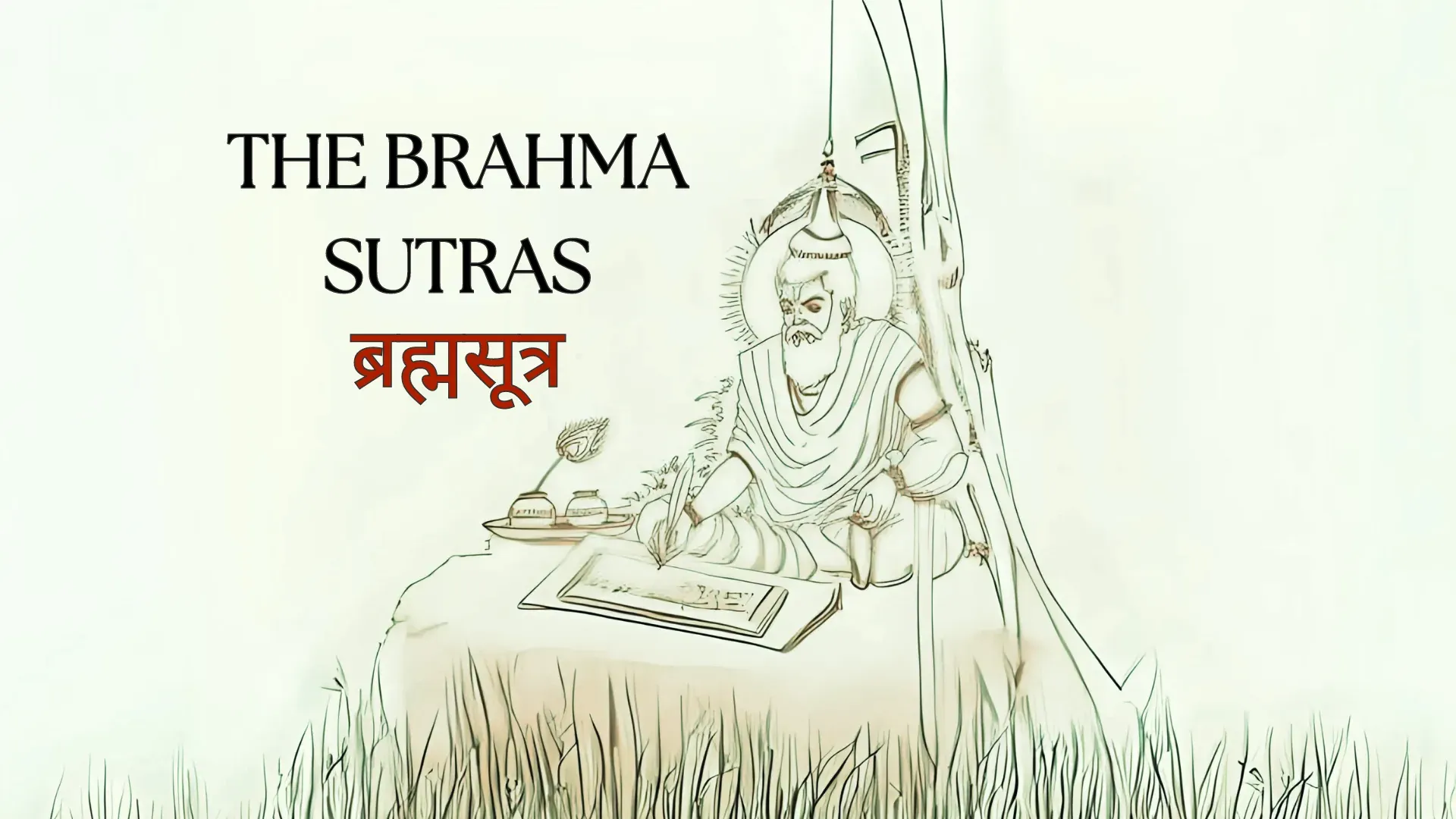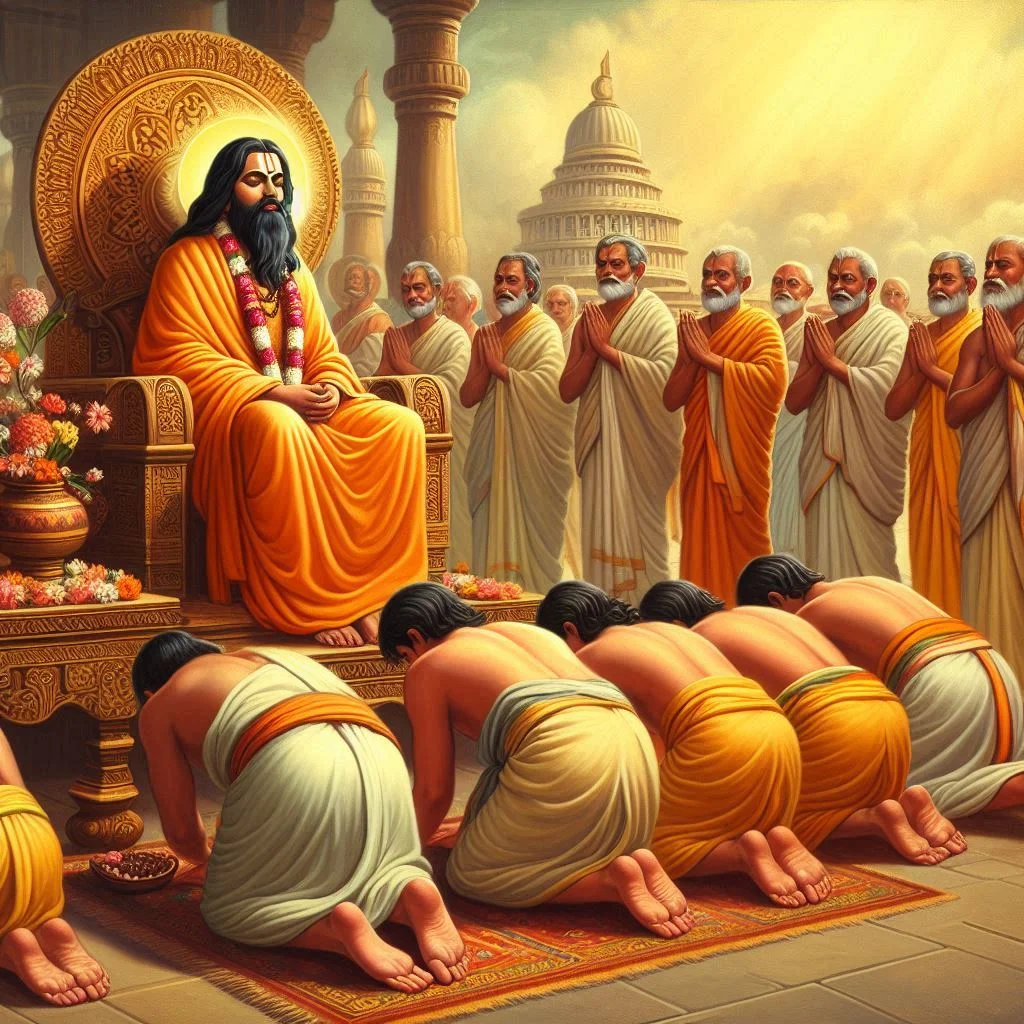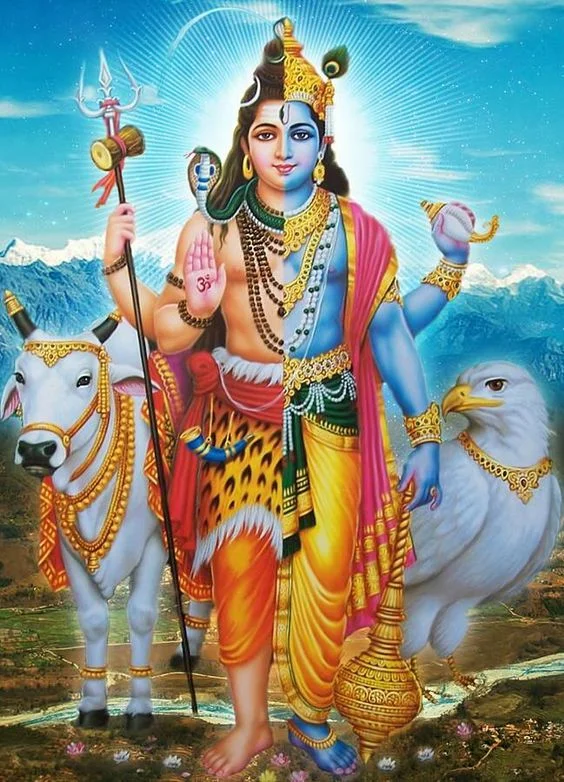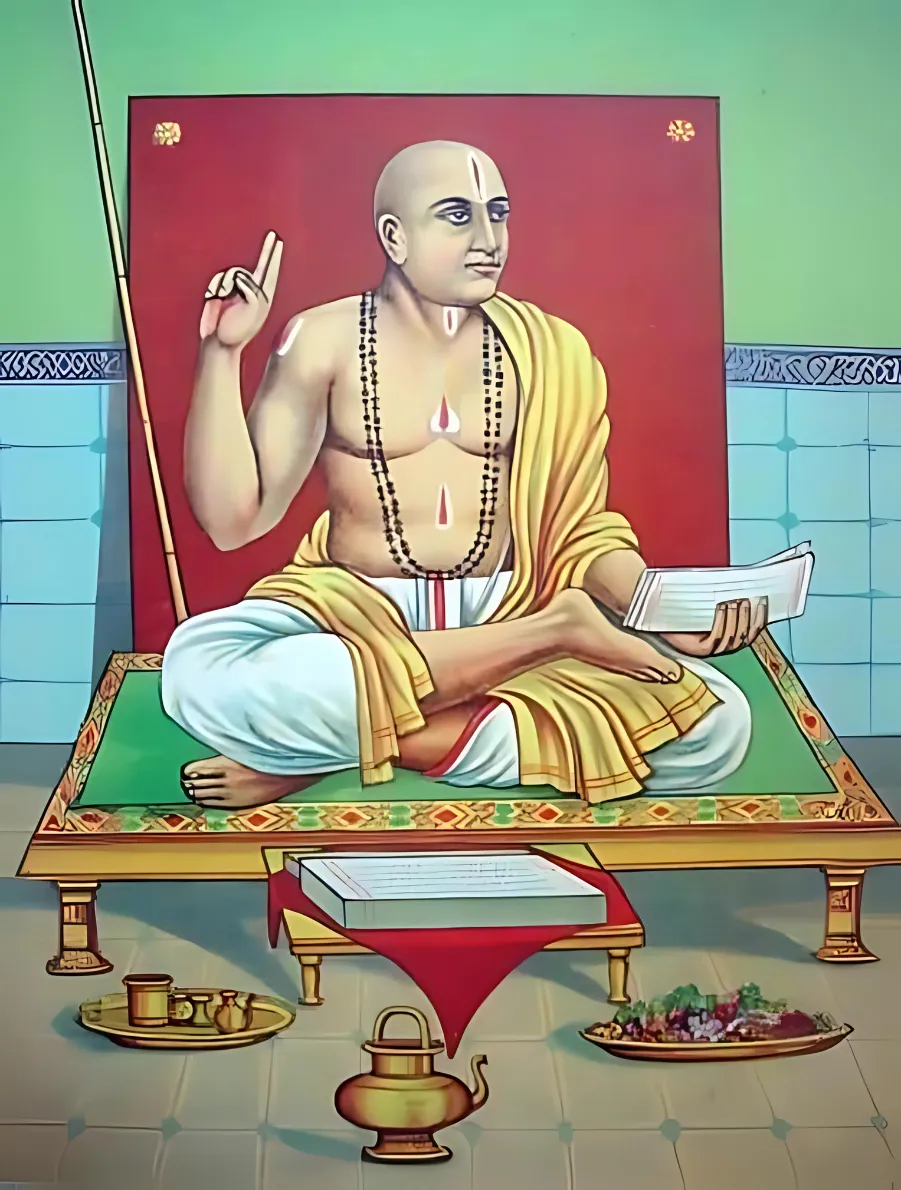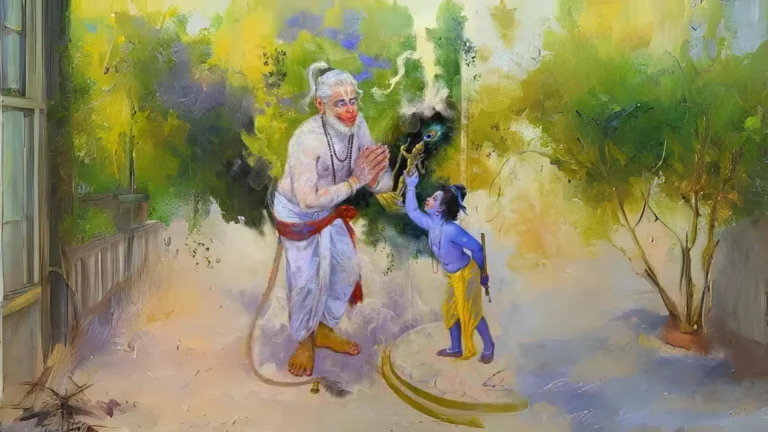Please Like the Blog and Share it for Maximum Reach
Table of Contents
Structure of The Brahma Sutras
Each pada contains structured sections called Adhikarana (अधिकरण) that comprises Sutras (सूत्र) or aphorisms. The Brahma sutra is a collection of a total- 555 aphorisms. Each chapter has a predefined objective. The first chapter called Samanvayadhyaya (समन्वय अध्याय) literally means the chapter of reconciliation.
Each Chapter of the Brahma Sutra focuses on bringing forward a central theme of the Upanishads, all put together. Each Upanishad has an isolated style of presenting the Ultimate truth. Each of them describe Brahman in a distinct manner. In the Upanishads, Brahman is the subject of exploration and a complete revelation.
Ignorance Towards Brahman
However, it is expressed in the form of profound statements that lie beyond the ken of a mind that has taken little or no effort in knowing Brahman. Upanishads use simple words to deliver the message of the Vedas, but talk about a subject matter that is very important and vital to our very existence but neglected by man, due to his ever-present ignorance. Thus, mere translation of the Upanishads cannot transmit the gravity it possesses.
The statements are rather cryptic and therefore only a Self-realized Acharya can decipher them and enunciate them for the welfare of mankind. The use of multiple terminologies to elaborate on Brahman can cause confusion because there appear stark contradictions among the Upanishads and even among multiple statements within the same Upanishad. Thus, to systematically address doubts that arise due to the multiplicity of expressions innate in the Shrutis, the first chapter of the Brahma Sutra was composed by Sage Veda Vyasa.
The Synthesis of Upanishads is the Brahma Sutras (The First Chapter)
In the first chapter, he establishes unity in the Upanishadic teachings regarding Brahman. He synthesizes diverse philosophical perspectives on Brahman to present a unified view of the Ultimate Reality. It convinces and assures the reader that no matter which Upanishad he is referring to, they are all elaborating and pointing towards that one Brahman alone. There is no other subject discussed in the Upanishads.
The Technique of Steelmanning (The Second Chapter)
The second chapter, Avirodhadhyaya (अविरोध्याय), aims at addressing and resolving apparent contradictions found within the teachings of the Upanishads. It also refutes the aspects of other philosophical schools that object to Vedanta by employing the steelmanning technique.
Steelmanning is to be understood here. This is a practice where a strong persuasive argument supporting a concept is constructed, even if the one presenting the concept may personally disagree with it. This is often done, in the field of philosophy and presenting spiritual arguments.
By Steelmanning, one is presenting an argument in a very strong manner, supporting it with other facts and supporting arguments. It also reflects that the one steelmanning, understands the subject matter completely and also totally respects an opposite view. This is also done to encourage constructive dialogues around the subject matter discussed.
When one is steelmanning an argument, critical thinking is improved and one’s own reasoning is improved, leading to better thoughtful exchanges. The Shankarabhasya critically addresses other schools with this sophisticated approach to highlight the impeccability of Vedanta.
A Synthesis of the Six Schools of Philosophy
In the commentaries of the second chapter the key ideas of Sankhya, Nyaya, Purva Mimamsa, Vaisesika Darsana, etc are acknowledged but their point of disagreement with Vedanata are proven ineffective in the quest of realizing the Absolute Truth.
For Example: Purva Mimamsa which deals with ritualistic practices for material benefits was critically addressed as subordinate to Brahman realization. The significance of the rituals were not denied but the lack of knowledge and shallow intentions to gain material benefits were claimed as stumbling blocks on one’s journey towards liberation. Similarly,
The Vaisheshika school has laid its foundation on atomic theory, giving precedence to scientific approach and matter over consciousness. Both Vaisheshika and Nyaya schools accept inference as a valid source of knowledge to understand the nature of Reality.
The Direct Path of Sri Adi Shankaracharya
However, Sri Shankaracharya proposed the necessity of Anubhava or direct, practical experience over random reasoning and deductions. Unless the scriptural revelations and philosophical ideas are experienced, man is yet far away from realizing Brahman. The prime goal of this chapter is to establish the supremacy of Vedantic perspective over other schools that do not completely adhere to it.
The main teaching of Sri Adi Shankaracharya is Jagat Mithya Brahma Satyam. According to Sri Shankara the world is an appearance and hence Maya or sullied Brahman. When the curtain of Maya falls, that Alone is Real, unsullied Brahman, for all is Brahman alone.
Various Approaches of the Upanishads
Thus, the Brahma Sutras acknowledge other doctrines and at the same time discards erroneous aspects that clash with Vedanta. This chapter of the Brahma Sutras also establishes that other Shastras and Vedanta are in complete harmony. Doubts regarding Upanishadic statements are clarified. Many individuals, unintentionally end up misconstruing the message of the Upanishads. This is because they are unable to pinpoint the focus of the Upanishad.
Some Upanishads focus on the Jiva, some on the process of Creation, some on the impersonal Brahman while certain others on Saguna Brahman, or Bhagwan. For Example: Many Upanishads advocate God as formless, all pervading, sinless, radiant, the one without form or attributes.
However, parallelly one cannot deny the implicit references of Rudra and Sri Narayana as Brahman. The Isa Upanishad also refers to the divine as encompassing both the manifested (Saguna) and the unmanifested (Nirguna) aspects of reality. To understand the form aspect of Brahman, it is advised to study Upanishads under the light of the Puranas and Itihasas that emphatically describe pastimes of Bhagawan and his avatars. All these scriptures fall under the purview of Sanatana Dharma.
We have to seek cohesion among all these scriptures as they are all talking about Brahman. So, as we have seen, the Upanishads seem to propagate the form (Saguna) and formless (Nirguna) aspects of God simultaneously. The presence of 2 contrasting viewpoints of Brahman, in the Upanishads can come across as errors to the common man who has never thought of defining God.
This can lead to chaotic misconceptions. Thus, the second chapter is systematically designed to bring to light seemingly contradictory statements from the Scriptures and reconciling them. This Chapter helps achieve a coherent understanding of the subject matter. Through the aid of pure logic and reason, Sri Vyasa has proven that there exists no inconsistency in the philosophical foundation of any of our scriptures. There surely does exist variegatedness, but there is no conflict within any statement of the Upanishads.
7/8 Questions from Sanatana Dharma
The scores generated in this Quiz may or may not be absolute. There may be right or wrong answers to each Question. A percentage towards 100 indicates that you are more aligned to the overall subject matter.
Spiritual Tools to Realize Brahman (The Third Chapter)
The third chapter called Sadhanadhyaya (साधनध्याय) delineates the practices and means to achieve our final goal. As the name suggests, it highlights the necessary spiritual discipline required to realize Brahman. Knowledge, Prayer, Meditation, Worship, etc are some practices. However, the interpretation of the Sadhanadhyaya completely relies on the commentary one is following.
Various Acharyas have written various commentaries and each of them has a particular focus. Due to this, the practice that is given utmost importance may vary from commentary to commentary.
The Path of Sri Shankara
For Example: The Śārīraka Bhasya of Sri Adi Shankarachary does not refute devotional practices. However, it categorizes them as mere preparatory practices that can help purify the mind. As Sri Shankara is the proponent of Nirguna Brahman, he emphasizes that other than self realization through Jnana Marga (or knowledge), there can be no other valid means to attain liberation. Rising above ignorance and realizing oneness can only be possible through Jnana.
Bhakti, meditation and other allied spiritual practices are useful in cleansing the mind and preparing us for our final goal. But, ultimately it is the fund of Jnana that shall reinstate us in a perfected self.
The Path of Sri Ramanujacharya and Sri Madhvacharya
Quite contrasting to this approach, the Sri Bhasya of Sri Ramanujacharya emphasizes Bhakti (devotion) as the primary path, and sees knowledge and rituals as supportive practices. Surrender and loving Bhagawan is crucial, and liberation is attained through His grace. This was the fundamental teaching of Vishishtadvaita Philosophy of Ramanujacharya.
The highlight of the Vishishtadvaita Philosophy is that the visible material world is real and that it constitutes the body of the Supreme Being. Hence rendering service to the beings of this world is akin to serving Bhagawan. Similar to the Adwaita principle, Vishishtadvaita believes that there are many similarities between Jiva and Bhagawan in quality, but Sri Bhagawan is invested with unlimited grace and power while Jiva’s power is infinitesimal.
Sri Madhvacharya the proponent of Dwaita Vedanta claims that a Bhakta is the one who always renders service while Bhagawan is the one who generously accepts the service. Because, Bhakti always maintains a clear distinction between the Jeevatma and Bhagawan, it is the only path that can lead to Moksha. Sri Madhvacharya is one who fiercely advocates that the Jeeva must be convinced of his eternal dependency on Bhagawan and Bhakti is the way to realize it.
Jnana Yoga and Karma Yoga are not effective towards liberation in the absence of Bhakti. In his Dwaita teaching, the main contrast as compared to the teachings of Vishishta Advaita is that Bhagavan, Jiva and the Material Energy or Maya are distinct and have nothing to do with each other. For that matter every Jiva is distinct from the other. This is where he vehemently differs with the Vishishtadvaita Philosophy. The goal of the Jiva however is to learn to depend on Bhagavan and serve Him through authorized Vedic Processes.
According to Dwaita Vedanta mere intellectual understanding of God is not sufficient. Developing unsullied love and complete surrender towards Bhagawan and ultimately Bhagawan’s infinite Grace shall initiate release of the soul from this endless loop of birth, death, aging, suffering and sorrow.
Thus, in Vishishtadvaita and the Dvaita Schools of philosophy practices that develop Bhakti towards Bhagawan are encouraged and become the basis of sadhana. In this approach Jnana has very little role to play. Thus, the Sadhanadhyaya has a range of interpretations to suit various sadhakas and gives everyone an opportunity to get into the spiritual path.
Due to the variety of commentaries and exegesis a sadhaka is always advised to follow the spiritual path under the fine guidance of a guru who shall extract the essence of the shastra for his sincere disciple. The disciple is simply expected to follow the sadhana marg as instructed by the guru, without an iota of doubt.
The Concluding Chapter of the Brahma Sutras
The last chapter also known as Phaladhyaya reveals the fruit of knowledge. Liberation or release from the cycle of birth and death, experience of the highest state, Brahman realization, etc are its topics of elucidation.
Thus, in 555 aphorisms and throughout the 4 chapters, complemented with the commentaries of great Acharyas, serious spiritual aspirants get a clear roadmap towards Liberation.
Please Like the Blog and Share it for Maximum Reach

